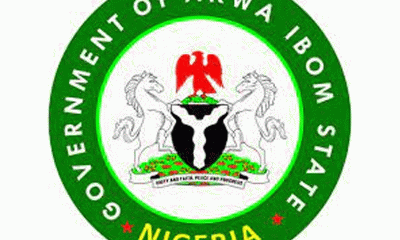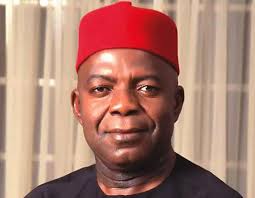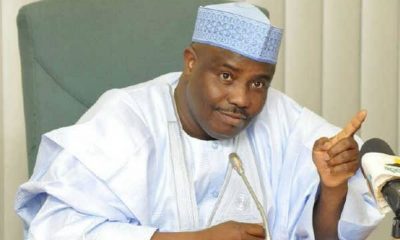FEATURES
When Helicopters Crash: Wigwe, Kobe, Iran…
By Reuben Abati
Media Vita In Morte Sumus (In the midst of life we are in death). This is a Gregorian chant that I often recall whenever there is an accident; a sudden, shocking abbreviation of life in the midst of hope and promise; a most tragic reminder of man’s mortality.
Life as either a chemical or biological process must come to an end when it will, but it is the time and manner it does that leaves the lasting imprint on our memory.
The tragic death of the President of Iran, Ebrahim Raisi (63), his foreign Minister, Hossein Amirabdollahian (60) and seven others in a helicopter crash on Sunday evokes these thoughts afresh, as well as frightening memories.Nigeria was thrown into shock in February this year when the tragic news was reported that Herbert Wigwe, group managing director and CEO of Access Holdings had died in a helicopter crash in the United States, along with his wife, Chizoba; his 29-year-old son, Chizzy; and his lawyer, Abimbola Ogunbanjo, on their way to the Super Bowl in Las Vegas. The quartet had a great future ahead of them.
Wigwe had just completed a university, the Wigwe University, in his home town of Isiokpo, Rivers State, through which he planned to raise educational standards and provide opportunities and quality. He and Ogunbanjo were full of life.
The death of three members of a family in one tragic accident was beyond comprehension. Nigerians and the international community mourned. The week before his death, I had received a phone call from Herbert, sharing his views about a subject we had discussed on “The Morning Show.” He was a kind, affable gentleman, completely without airs. I know many people in high places who are just full of hydrogen, with blown up ego. Not Wigwe.
Herbert Wigwe’s life was short, but his impact was profound. As was the case also with Kobe Bryant, American professional basketball player, five-time NBA champion, two times NBA Finals Most Valuable Player and NBA Most Valuable Player (2008), one of the most outstanding men on America’s basketball court. He died in a helicopter crash on 26 January, 2020, along with nine others, including his 13-year-old daughter, Gianna. They were going for a basketball game in Thousand Oaks, California.
And now again, in the past few days, there has been yet another case of a helicopter crash involving prominent persons in Iran: the President, the Foreign Minister and seven others. They were returning from a diplomatic mission to Azerbaijan, namely, the inauguration of a dam at the Eastern border, which was attended by President Ilham Aliyev of Azerbaijan.
It took a search and rescue party led by the Iranian Red Crescent Society, scouting around for 15 hours, before it was confirmed yesterday morning that the wreckage of the helicopter had been found, and there were no signs of life.
President Ebrahim Raisi was a prominent political and religious figure in Iranian politics. He and the late Foreign Minister were aligned with the conservative and hardline factions in Iranian politics. Raisi had served as a prosecutor in his early years, and as a member of a panel of judges, the so-called Assembly of Experts, which sanctioned the execution of political prisoners.
He later became Attorney General of the Republic. He ran for the Presidency in 2017, but lost to the more moderate Hassan Rouhani. He would be lucky in 2021 when he won, and became President in what was a controversial election with low voter turn-out.
It was believed that his emergence as President was carefully managed by his mentor, the man who has the final say in all matters in Iran, the Supreme Leader, Ayatollah Ali Khameini. He was looking forward to running for a second term in office in 2025. And now he is dead.
It was under his watch in 2022, for example, that a 22-year-old woman, Mahsa Amini, was detained, and allegedly killed in detention for wearing a loose headscarf. In the course of the mass protests that followed, more than 500 people were killed, over 22,000 others were detained. He is praised, however, for the diplomatic truce that was reached with Saudi Arabia last year.
In all the three cases of deaths resulting from helicopter crashes cited above, one common thread is that every accident occurred as a result of the malfunctioning of the helicopter and weather issues as well. In the Wigwe case, the reports cited poor weather, rain and showers in the area of the crash, on the edge of the Mojave Desert Preserve.
When Kobe Bryant died in a helicopter accident at Calabasas, investigators also cited poor visibility and low cloud ceiling, in addition to pilot error. Preliminary investigations into the crash in Iran have indicated challenging weather conditions and technical fault. In a political twist to the Iran incident, former Iranian Foreign Minister Mohammad Javad Zarif blames US sanctions for the crash.
The truth is that Iranian aircraft cannot be serviced with spare parts, due to sanctions, and hence, the fleet belongs to the pre-1979 Revolution era, old and deteriorating. The helicopter that crashed did not even have a functional signal system. Besides, the Bell 212 that crashed is US-made.
In all three, the aircraft crash landed and burst into fire. But the thing about death is that even “in the midst of death, there is life, and that should shock us” – a reversal of the original saying by James Koester.
Herbert Wigwe died on Friday, 9 February. By Monday, 12 February, the Board of Access Holdings Plc had announced Ms Bolaji Agbede as the acting group chief executive officer. By 14 March, the company re-appointed its co-founder, and non-executive chairman, as Chief Executive Officer of Access Holdings in a substantive capacity.
Kobe Bryant’s wife, Vanessa has at every turn memorialised and honoured her husband, Kobe, but she and her three surviving daughters have embraced life with equanimity. The family naturally feels the pain of death most; some people never heal, but still life goes on.
In Iran, the Supreme Leader, Ayatollah Khameini has urged the nation not to worry, and that “there will be no disruption in the country’s work.” Iran has declared five days of mourning, and the first official state funeral will take place today. Meanwhile, the Cabinet of ministers has met, and replacements have been announced.
Article 131 of the Iranian Constitution prescribes that in the event of the death of the President, the first Vice President assumes office, hence Mohammed Mokhber is now the Acting President of Iran. Ali Bagheri Kani, former Deputy Foreign Minister is also now the Acting Foreign Minister.
Within 50 days, the Constitution prescribes that a new election must be held to elect another President. So, even in Iran life goes on. What remains is the country’s next election in early July. Who will be Iran’s next President? A hardliner or a moderate and what would be the implications of the choice among likely candidates at a time Iran faces serious economic, regional and global challenges?
Helicopters are scary things, from the swirling blades that you have to be mindful of as you board or disembark, to the fact that they are very shaky most of the time when they are air-borne, especially when there is a little shift in the weather condition.
Helicopters are not as stable as regular planes. One of the reasons I felt all hope was not lost when the Jonathan administration left office in 2015 was that I would not have to travel in those machines again, at least not as part of my regular duty routine.
In 2012, it was a really sad moment for the Nigerian government when the National Security Adviser, General Andrew Owoye Azazi; Governor of Kaduna State, Patrick Yakowa, and four others died in a Navy helicopter crash in the forest of Okoroba in Nembe Local Government Area of Bayelsa State on their way to the Port Harcourt International Airport.
The helicopter burst into flames; its occupants were burnt beyond recognition. Every Nigerian President and senior government officials use the helicopter a lot, to cover distances, and in our time, the helicopter was the regular shuttle from the airport to the Villa, or to some nearby locations. On more than one occasion, going to the same Bayelsa state from Port Harcourt, we have had quite some anxiety.
The President directed, there and then, that on our way back from Davos, if the weather was still foggy, we would all return to Geneva by road. No helicopters ride in that kind of foggy weather.
Later that year, July 2013, President Goodluck Jonathan was in China on a five-day state visit. It was a significant trip to strengthen bilateral relations between Nigeria and China. We were well received and everything went well. The hospitality was great.
The chemistry was right. But I recall that one of the programmes on our list could not take place. We were to visit a particular province, but the issue came up that we would have to go in a Chinese aircraft, flown by Chinese pilots, because the route to the province is mountainous and even only carefully chosen and trained pilots are allowed to fly on that route.
Helicopter crashes have claimed the lives of many prominent state officials in the line of duty, including President Rene Ortuno of Bolivia (1969), Prime Minister Rashid Karami of Lebanon (1984), Burundi Defence Minister Colonel Firmin Sinzoyiheba (1998), President Ibrahim Nasir of the Maldives (2008), Vice President John Garang of Sudan (2005), and Chief of Kenya’s military, General Francis Omondi Ogolla (2024).
There is also a long list of leaders across the world who died in plane crashes. Between man, technology and nature, there is a lot about man’s inability to master and control the universe. There have been survivors though: In February 2019, Vice President Yemi Osinbajo of Nigeria escaped unhurt from a helicopter crash in Kabba, Kogi State. In Iran, two helicopters travelling with President Ebrahim Raisi made it back to Tehran safely. Life is complex, the mysteries within it are far more so. May the souls of all departed persons find peace eternal.
FEATURES
Nigeria’s Fight To Eliminate Hepatitis In Prisons
By Rachea Abuja
In Nigeria, estimates from the National AIDS, STIs and Hepatitis Control Programme (NASCP) show that 8.1 per cent of adults aged 15–64 live with hepatitis B, and 1.1 per cent with hepatitis C.On a worrisome note, more than 80 per cent of those infected are unaware of their status, enabling the virus to spread silently, in homes, hospitals, and correctional facilities.
Public health experts say correctional centres are among the highest-risk environments for viral hepatitis due to overcrowding, unsafe medical practices, limited access to testing, and stigma. According to the World Health Organisation (WHO), viral hepatitis, particularly types B and C, is a global public health threat that kills approximately 1.3 million people each year, making it second only to tuberculosis among infectious diseases.In spite of its deadly toll, hepatitis is often overlooked, especially in low- and middle-income countries like Nigeria.More than 91 million people in the WHO African region live with hepatitis B or C, representing 26 per cent of the global burden.Shared razor blades, contaminated injection equipment, and poor sanitation all contribute to the spread.When 34-year-old Malam Musa Danladi was arrested, tried and sentenced in 2022, he knew prison would be tough; but what he did not expect was that a place of punishment would become a place of diagnosis, for a disease he had never heard of.“They called me to the clinic one morning; I was confused; the nurse said I had hepatitis B; I did not even know what that meant.”He is one of thousands of Nigerians living with viral hepatitis, a disease that often shows no symptoms until it causes irreversible damage to the liver.Danladi is also among the few who discovered their status within prison walls.“We used to share everything, razors, clippers, even toothbrushes; Nobody told us we were at risk.“Incarcerated people face a triple burden: poverty, stigma, and disease, with few resources or pathways to care,” Danladi said.In a bid to reverse this trend, the Nigerian government, in July, unveiled Project 365, a year-long national campaign to test, treat, and vaccinate millions of Nigerians for hepatitis, including those in prison settings.The unveiling coincided with World Hepatitis Day, with the theme: “Hepatitis Can’t Wait- Test. Treat. Eliminate.”According to Prof. Muhammad Ali Pate, Coordinating Minister of Health and Social Welfare, Nigeria is losing between ₦10.3 trillion and ₦17.9 trillion annually to hepatitis-related productivity and healthcare costs.“Project 365 is about saving lives and saving our economy,” he said.Pate said that the project 365 aimed to screen every federal constituency in Nigeria, totaling 360, and to deliver curative treatment for hepatitis C as well as vaccination for hepatitis B.He said it also sought to expand outreach to prisons, internally displaced persons (IDP) camps, rural communities, and other underserved regions.The minister said it would ensure sustainable financing for testing and treatment, and the initiative established the Viral Elimination Fund (VEL).Additionally, he said that the project 365 would promote local production of hepatitis diagnostics and medications, supported by tax incentives and regulatory reforms, to reduce reliance on imports.At Kuje Medium Security Custodial Centre, a pilot hepatitis programme under the Viral Hepatitis Action in Correctional Services screened 830 inmates between December 2024 and June 2025.Dr Ibrahim Ehizogie, a clinician with the Nigerian Correctional Services, said that many inmates were already infected with the disease while in custody.Ehizogie said that the programme was now being scaled across Nigeria’s six geopolitical zones, with a target to reach all 300 custodial centres in the country.However, experts warn that without continued funding, education, and policy enforcement, these gains may be short-lived.According the 2024 INHSU Global Guideline on the Elimination of Hepatitis C in Prisons, incarcerated individuals have the same right to healthcare as the general population, and that denying hepatitis services in custody violates international human rights standards.The guideline recommends that inmates should be tested and initiated on treatment within seven days of incarceration.It also emphasises the integration of harm reduction services, such as safe injection practices and opioid substitution therapy, to reduce transmission.Furthermore, the guideline advocates for peer-led education and community-based screening models to increase uptake and reduce stigma, and stress the importance of ensuring continuity of care upon release, so that individuals can maintain their treatment and health outside prison walls.Dr Mya Ngon, WHO Team Lead for Communicable and Non-Communicable Diseases, commended Nigeria’s efforts.Ngon said that screening must be linked to treatment, and treatment must be linked to continuity of care, even after prison.Since his release, Daladi has become a community advocate, telling others about hepatitis, its transmission, and the importance of testing.“I did not die in prison; so, I want to use my voice; people need to know it is not a death sentence; you can treat it; you can live; but stigma remains.“Some people say I brought prison sickness home; some would not even shake my hand,” he said.According to him, at present, he works in his community to support reintegration and health education, urged the government to expand outreach to ex-inmates and low-income communities.In spite of the progress of Project 365, experts identify critical gaps in Nigeria’s hepatitis response; they say female inmates and pregnant women in custody are often excluded from routine hepatitis screening, leaving a critical gap in care.Prof Taiwo Lateef, Professor at ABU and Africa Lead for Lifeline International, said that harm reduction services, such as access to sterile injecting equipment or safe drug treatment options, were largely absent in correctional centres.In many cases, Lateef noted that the continuity of treatment after release remained uncertain, making long-term management of the disease difficult.He said that youth offenders and first-time detainees typically received little to no education on hepatitis prevention, increasing their vulnerability.Lateef said that Nigeria did not have a national hepatitis registry for prisons, making it challenging to track disease prevalence, monitor treatment coverage, or evaluate outcomes in custodial settings.Dr Adebola Bashorun, National Coordinator for NASCP, said that without structured data and legal protections, prison health reform would remain incomplete.Bashorun said that Nigeria’s hepatitis elimination strategy was ambitious and commendable.He said that success would require multisectoral partnerships, political will, and a people-first approach.According to, Dr Titilola Munkail, Technical Officer at Africa CDC, one cannot talk about ending hepatitis if one ignores people behind bars.Munkail said that prisons were not separate from public health.“They are central to it,” he said.As Nigeria races toward the 2030 elimination goal, stakeholders urge the government, civil society, and citizens to act.They say there is need for the government to institutionalise hepatitis services in all correctional facilities and primary healthcare centres (PHCs) to ensure consistent and equitable access to care. (NANFeatures)FEATURES
Embracing Holistic Care in Sickle Cell Disease Management: A New Dawn of Hope for Warriors

By Obi Light Ogbonnia
Sickle Cell Disease (SCD), a hereditary blood disorder affecting millions worldwide, is especially prevalent in Nigeria, where over 150,000 children are born with the condition annually. Many do not live past the age of five due to poor access to quality healthcare, lack of awareness, and stigmatization.
For those who survive, the journey is often one of pain, crisis, and repeated hospitalization.While medical science continues to make commendable strides through bone marrow transplants, hydroxyurea, and advanced diagnostics, it is clear that clinical solutions alone are not enough. A comprehensive, holistic care model is urgently needed, one that views the patient not just as a set of symptoms, but as a whole person deserving of dignity, compassion, and support.
What is Holistic Care in SCD?
Holistic care is a patient-centered approach that addresses the physical, emotional, psychological, spiritual, nutritional, and social aspects of life. In the context of sickle cell disease, this means going beyond medications and crises to provide wraparound care that sustains both body and spirit.
Key components include: Effective pain management (both medical and non-pharmacological), Mental health support (counseling, therapy, peer support), Nutrition and hydration guidance, Faith-based and spiritual care, Family and caregiver education, Community awareness and social empowerment and Managing Pain Beyond the Hospital Bed
For many warriors, pain crises are the most debilitating part of SCD. While analgesics and opioids are standard treatments, integrating heat therapy, meditation, music, art therapy, massage, and breathing exercises can significantly reduce frequency and severity of pain episodes. These methods also help reduce emotional trauma and dependence on medication.
Mental and Emotional Health: The Invisible Crisis
The psychological impact of SCD, especially depression, anxiety, and social isolation, is often ignored. Many warriors, especially adolescents, suffer in silence. Incorporating professional counseling and trauma-informed therapy within SCD clinics can make a life-saving difference.
Support groups, storytelling platforms, and psychosocial interventions can empower warriors to share, heal, and thrive.
Food, Faith, and Lifestyle
Good nutrition is not a luxury for warriors, it is essential. Diets rich in folate, vitamins, fruits, vegetables, and adequate hydration help in blood formation and crisis prevention. Alongside this, moderate exercise, adequate rest, and temperature regulation are vital.
For many, faith remains an anchor. Whether through prayer, pastoral care, or spiritual counseling, holistic care honors the emotional strength that comes from belief and community.
Families: The First Line of Care
No warrior walks alone. Family members—especially mothers—often carry the burden of care without support or training. We must empower caregivers with knowledge, resources, and rest. Providing community-based education programs, crisis response training, and emotional support for caregivers is a cornerstone of holistic health.
A Call to Action for Policymakers and Society
Holistic care must become part of national policy. We urge the Nigerian government and health institutions to:
Invest in multidisciplinary SCD care centers
Train and employ social workers, psychologists, nutritionists, and pastoral caregivers
Include mental health and alternative therapies in national health insurance coverage
Fund grassroots awareness and education campaigns
Conclusion: From Surviving to Thriving
As a 51-year-old sickle cell warrior myself, I speak from lived experience: sickle cell disorder does not define us. With the right support, we can live full, joyful, productive lives. Holistic care is not an ideal—it is an urgent necessity.
The Obi Ogbonnia Sickle Cell Foundation was born from this conviction—to raise awareness, provide support, and advocate for those who cannot fight alone. We invite governments, NGOs, faith-based organizations, and individuals to partner with us in this mission.
Let us not allow another warrior to perish due to lack of compassion, knowledge, or access. Let us create a new future—where every sickle cell warrior lives with dignity, wellness, and hope.
Obi Light Ogbonnia is the Founder, Obi Ogbonnia Sickle Cell Foundation, info@ooscf.com, +2348057157133, www.ooscf.org.ng
FEATURES
When Will The Road Killings Stop?

By Sale Rusulana Yanguruza
Nigeria has today counted and witnessed multiple killings of innocent people and bombings of citizens on the roads from different angles in the South and some Northern parts of Nigeria. Unfortunately, none of the perpetrators have been brought to face the wrath of the law.
In less than two months, 16 hunters were killed by mob youth in Uromi, Enugu State, and the details about those arrested and suspects are still undisclosed to the members of the public.
Their families and the Hausa people are mourning the death of these innocent individuals who were brutally killed, but the silence of the government is devastating. Even the compensation that Governor Abba Kabir Yusuf promised and requested from the Edo State government is still unclear to the members of the public.The most devastating aspect of the road killings is that most of the victims are Hausa or Muslim, simply because they are from the North. How can traveling on the roads be a reason to kill a citizens? Why are Hausa and Muslim individuals always the victims ? Is it only hausa people traveling by the road in Nigeria?
Even though the answers that these youths usually give is that Fulani and terrorists are killing them overnight, that is not a reason to block roads and kill innocent people. They should know that Zamfara, Katsina, Kaduna, Niger, and Borno States are facing insecurity challenges like kidnapping, Boko Haram and Fulani clashes for over a decade, but none of the people from these states view a particular tribe or religion as the cause and use roads to kill innocent people.This act should be stop!
No doubt, Constitutionally, every individual in this country is entitled to move anywhere and leave wherever he/she wish to leave but unfortunately for Hausa and some Muslim individuals, traveling by road seems to be considered a sin by some youth, leading to serious punishment, which is barbaric killings by their so-called fellow citizens who do not have emotional feel for human being and their compatriots citizens .
I believe that in Nigeria, no tribe is exempt from traveling from one place to another. However, it’s saddening and regrettable that the Hausa people are disproportionately affected and become victims of road killings, and the government is still yet to take necessary actions to deal with such inhumane and unfathomable actions carried out by some groups.
The most terrible and gruesome aspect of such acts is that every day, the situation rises to an unbearable and unacceptable level. It’s imperative and necessary for the government to end these ongoing road killings before it will escalate to an uncontrollable level.
The government shouldn’t limit its activities to only condemning and sending condolence messages to the families victims of these inhumane and unfathomable killing of innocent people; actions must be taken, and the punishment of those involved in such road killings must be brought to public eyes.
No doubt, swift punishment would aid in reducing these ethno-religious killings in the country and would serve as a reference and warning to such mob groups that the government is prioritizing and exercising its constitutional duties as a government in protecting the lives of its citizens who are brutally killed and burned.
Doubtless, Most of the victims are from Kano State, where the majority of travelers from all 36 states enter the state everyday to carry out their business activities, considering the state as a center of commerce. Still, none of the travelers from other ethnic groups were killed and burnt in Kano. Why do some groups choose to reward these people with the killings of their own brothers and sisters ?
It’s very alarming to note the numbers of Northerners killed simply because they’re traveling is rising every month, with no concrete reasons to justify their offenses, but merely due to their identity as Northern Muslims or Hausa by tribe. Additionally, Truck drivers have continuously faced these killings over the past eight years, yet no actions have been taken to avert further escalation and end it permanently.
In one editorial written by a popular newspaper in Nigeria, it’s reported that over 50 drivers have been killed and even burned their goods with some still missing due to this animalistic attitude of road killings. In May 2022, a pregnant woman, Harira Jubril, 32, and her four children were killed in the Orumba South Local Government Area of Anambra State. Even those who committed this act haven’t faced the wrath of the law.
One may ask: Is the government truly ready to end these barbaric killings that keep surging towards a particular or specific religion or tribe? Regrettably, in 2023, a group of mob killed about 20 people who were going for religious activities. All of them are Muslims. But who are the suspects, where are they, and what actions has the government taken on the perpetrators?
The people who killed those going to Maulud are the same people who recently killed those going for a wedding in a University Bus carrying the name of Ahmadu Bello University Zaria written in bold with a plate number to stop them and killed and burnt the car . What offense do they commit? How can a University bus carry terrorists and travel on the roads? The most disheartening aspect of these barbaric and animalistic acts is that they’re killing and burning people and still celebrating the deaths of these individuals; taking video footage-How heartless!
Do you think the government punishes those who killed the people going for Maulud, the Uromi 16, Harira Jubril and her four children, in public? The mob group would never dare attempt to do it again, sadly what is happening now is worrisome because the inactions is making the situation to take another dimension.They may believe that since several incidents, no actions have been taken to punish and bring them to book publicly, so it’s okay to repeat it again.May be it’s for this reason, recently, some of the mob group from Benue state killed Jamilu Ahmad and Barhama Suleiman who are from Kano State just in less than a week plateau group killed 13 and injured others.
Advisedly, the government and stakeholders must come up with security strategies and measures that will bring an end to these road killings. This can be achieved by updating the public about those arrested and who committed this animalistic act, to bring them to book and let the world know they have been punished.It’s notable that they celebrate the killing of people, take videos, and share them publicly, showcasing what they’ve done. If they can confidently act in such a manner, why is the government not updating the public about what happened to them after they’ve been arrested and taken to court?
| ReplyReply allForwardAdd reaction |



















